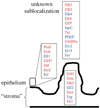Ets transcription factors in intestinal morphogenesis, homeostasis and disease
- PMID: 18785124
- PMCID: PMC2716142
- DOI: 10.14670/HH-23.1417
Ets transcription factors in intestinal morphogenesis, homeostasis and disease
Abstract
Ets transcription factors comprise a large family of sequence-specific regulators of gene expression with important and diverse roles in development and disease. Most Ets family members are expressed in the developing and/or mature intestine, frequently in a compartment-specific and temporally dynamic manner. However, with the exception of the highly expressed Elf3, involved in embryonic epithelial differentiation, little is known about Ets functions in intestinal development and homeostasis. Ets factors show altered expression in colon cancer, where they regulate pathways relevant to tumor progression. Ets factors also likely act as important modifiers of non-neoplastic intestinal disease by regulating pathways relevant to tissue injury and repair. Despite a large body of published work on Ets biology, much remains to be learned about the precise functions of this large and diverse gene family in intestinal morphogenesis, homeostasis, and both neoplastic and non-neoplastic pathology.
Figures



Similar articles
-
Ets transcription factors control epithelial maturation and transit and crypt-villus morphogenesis in the mammalian intestine.Am J Pathol. 2009 Apr;174(4):1280-90. doi: 10.2353/ajpath.2009.080409. Epub 2009 Mar 5. Am J Pathol. 2009. PMID: 19264912 Free PMC article.
-
Multiple roles of the epithelium-specific ETS transcription factor, ESE-1, in development and disease.Lab Invest. 2012 Mar;92(3):320-30. doi: 10.1038/labinvest.2011.186. Epub 2011 Dec 12. Lab Invest. 2012. PMID: 22157719 Review.
-
Inactivation of the transcription factor Elf3 in mice results in dysmorphogenesis and altered differentiation of intestinal epithelium.Gastroenterology. 2002 May;122(5):1455-66. doi: 10.1053/gast.2002.32990. Gastroenterology. 2002. PMID: 11984530
-
Epithelial-specific ETS-1 (ESE1/ELF3) regulates apoptosis of intestinal epithelial cells in ulcerative colitis via accelerating NF-κB activation.Immunol Res. 2015 Jun;62(2):198-212. doi: 10.1007/s12026-015-8651-3. Immunol Res. 2015. PMID: 25926267
-
ELF3, ELF5, EHF and SPDEF Transcription Factors in Tissue Homeostasis and Cancer.Molecules. 2018 Aug 30;23(9):2191. doi: 10.3390/molecules23092191. Molecules. 2018. PMID: 30200227 Free PMC article. Review.
Cited by
-
Altered intestinal epithelial homeostasis in mice with intestine-specific deletion of the Krüppel-like factor 4 gene.Dev Biol. 2011 Jan 15;349(2):310-20. doi: 10.1016/j.ydbio.2010.11.001. Epub 2010 Nov 9. Dev Biol. 2011. PMID: 21070761 Free PMC article.
-
Fibroblast growth factor 10 represses premature cell differentiation during establishment of the intestinal progenitor niche.Dev Biol. 2011 Jan 1;349(1):20-34. doi: 10.1016/j.ydbio.2010.09.010. Epub 2010 Sep 27. Dev Biol. 2011. PMID: 20883684 Free PMC article.
-
ETS-4 is a transcriptional regulator of life span in Caenorhabditis elegans.PLoS Genet. 2010 Sep 16;6(9):e1001125. doi: 10.1371/journal.pgen.1001125. PLoS Genet. 2010. PMID: 20862312 Free PMC article.
-
Elevated expression of p53 in early colon polyps in a pig model of human familial adenomatous polyposis.J Appl Genet. 2018 Nov;59(4):485-491. doi: 10.1007/s13353-018-0461-6. Epub 2018 Aug 25. J Appl Genet. 2018. PMID: 30145695
-
The Ets dominant repressor En/Erm enhances intestinal epithelial tumorigenesis in ApcMin mice.BMC Cancer. 2009 Jun 22;9:197. doi: 10.1186/1471-2407-9-197. BMC Cancer. 2009. PMID: 19545444 Free PMC article.
References
-
- Baldus CD, Liyanarachchi S, Mrozek K, Auer H, Tanner SM, Guimond M, Ruppert AS, Mohamed N, Davuluri RV, Caligiuri MA, Bloomfield CD, de la Chapelle A. Acute myeloid leukemia with complex karyotypes and abnormal chromosome 21: Amplification discloses overexpression of APP, ETS2, and ERG genes. Proc. Natl. Acad. Sci. USA. 2004;101:3915–3920. - PMC - PubMed
-
- Behrens P, Mathiak M, Mangold E, Kirdorf S, Wellmann A, Fogt F, Rothe M, Florin A, Wernert N. Stromal expression of invasion-promoting, matrix-degrading proteases MMP-1 and -9 and the Ets 1 transcription factor in HNPCC carcinomas and sporadic colorectal cancers. Int. J .Cancer. 2003;107:183–188. - PubMed
-
- Bertrand V, Hudson C, Caillol D, Popovici C, Lemaire P. Neural tissue in ascidian embryos is induced by FGF9/16/20, acting via a combination of maternal GATA and Ets transcription factors. Cell. 2003;115:615–627. - PubMed
-
- Brent AE, Tabin CJ. FGF acts directly on the somatic tendon progenitors through the Ets transcription factors Pea3 and Erm to regulate scleraxis expression. Development. 2004;131:3885–3896. - PubMed
-
- Brown C, Gaspar J, Pettit A, Lee R, Gu X, Wang H, Manning C, Voland C, Goldring SR, Goldring MB, Libermann TA, Gravallese EM, Oettgen P. ESE-1 is a novel transcriptional mediator of angiopoietin-1 expression in the setting of inflammation. J. Biol. Chem. 2004;279:12794–12803. - PubMed
Publication types
MeSH terms
Substances
Grants and funding
LinkOut - more resources
Full Text Sources
